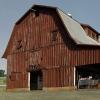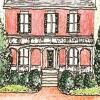UGA Is Getting a New Vet School and Business College
Athens Rising

A preliminary design for new Terry Business Learning Community.
In 1785, the Georgia General Assembly chartered the University of Georgia, the first state university in the nation. In the summer of 1801, John Milledge purchased 633 acres for $4,000 and donated them to the state, and thus the University of Georgia, along with the city of Athens, was formed. Classes, led by Josiah Meigs, the first president and professor of the university, began in September, taught under the trees of what is now North Campus. The first permanent building on campus was completed in 1806. We now know this building as Old College, but at the time it, as well as the university, was unofficially referred to as Franklin College. Old College was modeled after Connecticut Hall at Yale, Meigs' alma mater.
Today, the University of Georgia sits on 605 of those original 633 acres—UGA sold several lots in what is now downtown in order to finance Old College—and though the university has grown far beyond the capacity of Old College, it still has room to grow. Under President Michael Adams, the university has continued to grow. Adams oversaw construction of the Miller Learning Center, the East Campus dorms and dining hall, Tate II, the new Lamar Dodd building on East Campus, the Special Collections Library, the Georgia Museum of Art expansion and the renovations of Myers Hall, Clark Howell, Candler Hall and the old Lamar Dodd building, now referred to as the Jackson Street Building. Adams is leaving this summer, but the university continues to expand.
Last November, a groundbreaking ceremony was held for the new Veterinary Medical Learning Center at the corner of College Station and Barnett Shoals roads. The site is currently being prepped, and construction should begin in late February or early March. The new building is not replacing the current vet school. The VLC will house several hospitals and barns and is a modern and expanded addition to the current school. It is to be designed by Perkins and Will, an architectural firm out of Atlanta that has designed buildings for Colorado State University, Appalachian State and many other colleges and universities.
Also coming up is a new four-building complex for the Terry College of Business. The Terry Business Learning Community will be located between Lumpkin and Hull streets in what is currently surface parking near the Special Collections Library. Construction on the first building is scheduled to begin later this summer and completed by fall 2014. The cost of the complex will end up being nearly $140 million. It will be built in three phases, with the first phase costing $35 million. As with the original donation that began the university, this $35 million building is also funded with donated money. The 75,000 square-foot first phase will house the MBA and other graduate programs, as well as administrative offices for the college.
The Board of Regents picked Hardin Construction of Atlanta to oversee the project, and the university hired Robert A.M. Stern architects to design it. Stern’s portfolio is filled with work from other colleges and universities across the country, including Harvard, the University of South Carolina, the University of North Carolina, Princeton and Yale, just to name a few. Though the design has not yet been completed, UGA Associate Vice President for Facilities Planning Danny Sniff says it will fit in with what's already on campus. Having looked through Stern’s portfolio, I can say I look forward to seeing what they will do on campus. Much of their academic architecture is a nice blend of traditional with just enough modernity to keep it relevant. The current Terry College, designed by architect Neil Reid, will eventually be repurposed.
As with all new construction on campus, these two new developments will be energy-efficient and incorporate LEED Silver principles. However, LEED certification is expensive, and so the university does not go through the process of being certified. At a time when money is tight and tuition continues to climb, I, for one, am glad to see UGA rein in spending while still holding itself to sustainable standards.
Keywords
More by Stella Smith
-

Is the Chain Gang Taking Over Downtown Athens?
Local businesses are closing or moving and chains are taking their place.
-

-

A Historic Garden Is Coming to the Ware-Lyndon House
No one knows what it might have looked like, but they're giving it their best shot.









comments